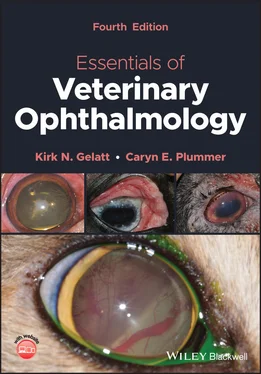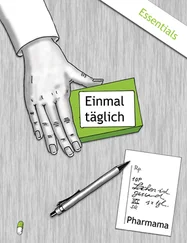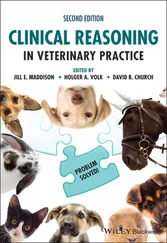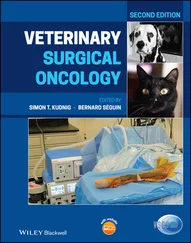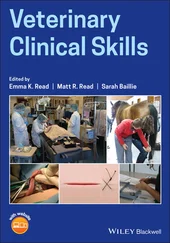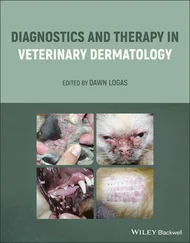Unlike mammals, chickens (and possibly lizards) also accommodate by changing the corneal curvature. Corneal accommodation is mediated by the anterior ciliary muscle. Contraction of Crampton's muscle, which originates in the sclera and inserts in the cornea, flattens the peripheral cornea and increases the curvature of the central cornea. Corneal accommodation is reported to play an important role in chicken accommodation, contributing 8–9 D. Thus, the reported combined (corneal and lenticular) accommodative power of the eye in young chicks is 25 D, compared with a maximal power of 15 D in children.
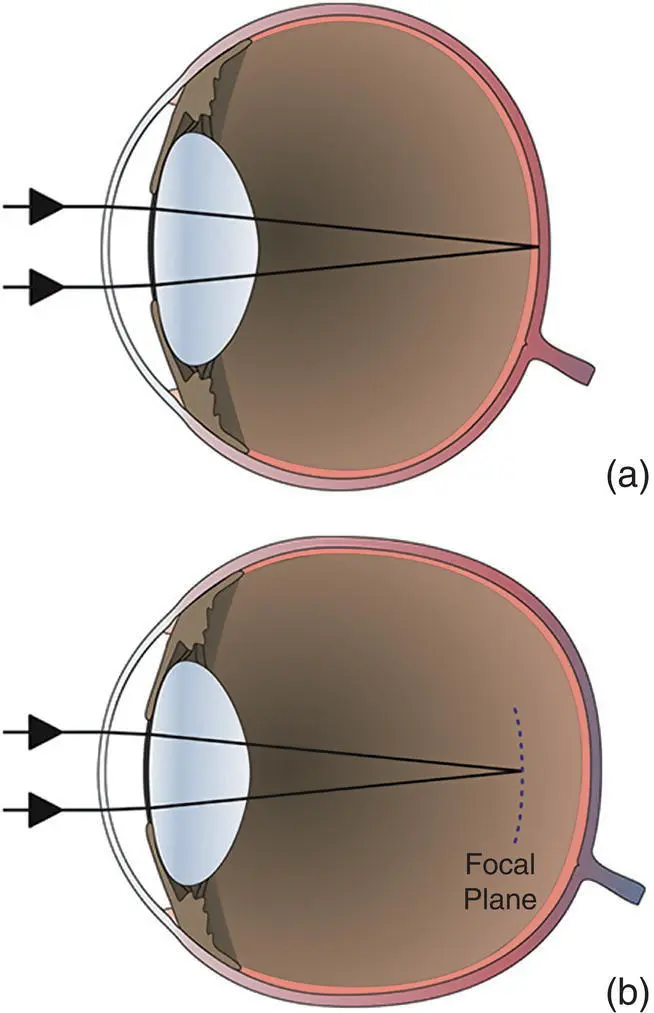
Figure 2.11 The effect of vitreous elongation on ocular refraction. (a) A focused emmetropic eye. (b) The refractive power of the eye has not changed, and the light is focused on the same spot as in panel (a). However, due to vitreous elongation, the retina has moved posteriorly, and therefore the light is now focused in front of the retina. As a result, the eye is now nearsighted or myopic.
The pupillary aperture is not considered to be a classic refractive structure as it has no refractive index, but it does make an important contribution to the resolving power of the eye. As the pupil dilates in dim light, the number of photons entering the eye increases, resulting in increased retinal illumination. However, there is “a price to be paid” for this increased illumination, as mydriasis also decreases the depth of focus of the eye. This means that as the pupil dilates, the range of distances at which objects remain in focus decreases.
Abnormal Refractive States and Optical Errors
Emmetropia and Ametropia
The “purpose” of refraction and the accommodative processes described in the previous sections is to focus an image on the outer segments of the photoreceptors. An emmetropic eye is one in which parallel light rays (from a distant object) are focused on the outer segments when the eye is disaccommodated. A nonemmetropic, or ametropic , eye is one in which the focused image (from a distant object) falls anterior to the retina (i.e., nearsighted or myopic eye) or posterior to it (i.e., farsighted, hyperopic or hypermetropic eye) (see Figure 2.12).
Retinoscopy is the most commonly used clinical method to determine the refractive state of the eye in young children and animals. It is based on two assumptions: first, that light emerging from the eye (i.e., emergent rays) follows the same optical path as light entering the eye; and second, that the fundus reflex originates at the level of the outer segments. If those two assumptions hold, then emergent rays exit an emmetropic eye as parallel rays, a hypermetropic eye as diverging rays, and a myopic eye as converging rays. Therefore, the location of the focal point formed by the emergent rays can be used to determine the refractive state of the eye. Table 2.15lists refractive errors in select species. Most of these values have been determined using streak retinoscopy , though autorefractors have also been used in veterinary medicine. A large survey found that, on average, dogs are indeed emmetropic, with a mean refractive error of −0.05 D. Nine dog breeds, including English Springer Spaniel, German Shepherd, Golden Retriever, Siberian Husky, Shetland Sheepdog, Labrador Retriever, Border Collie, Samoyed, and “other” terriers were found to be emmetropic (defined as having a mean refractive error <0.5 D in either direction). The same study also found that 8% of all dogs were hypermetropic, with a refractive error of up to +3.25 D. Three breeds (Australian Shepherd, Alaskan Malamute, and Bouvier des Flandres) were found to have a mean refractive error that was hypermetropic.
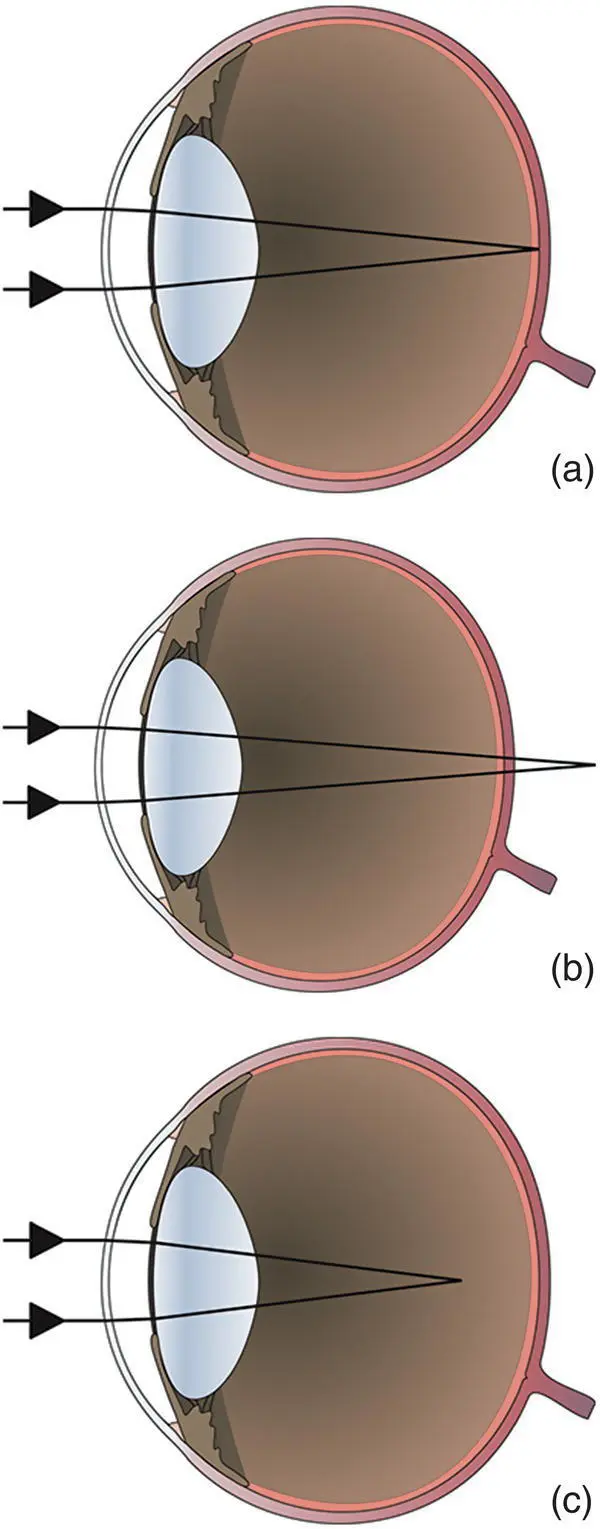
Figure 2.12 (a) In emmetropia, parallel light rays are focused on the retina. (b) In a farsighted (hypermetropic or hyperopic) eye, light rays are focused behind the retina. (c) In a nearsighted, or myopic, eye, the light is focused in front of the retina.
A study in cats reported that kittens (≤4 months) are myopic, with a mean error of −2.45 D, while adult cats are close to emmetropia, with a mean error of −0.39 D, thus demonstrating a significant effect of age. It is interesting to note that myopia decreases with age in cats, but in horses and in some dog breeds, notably the English Springer Spaniel and Beagle, it increases with age.
Several large studies have shown horses to be overall emmetropic. However, only 48–68% of horses are emmetropic in both eyes, with hyperopia and myopia reported in equal proportions in the ametropic horses, with errors of up to ±3 D. Age and breed may affect the refractive error in horses.
A large range of retinoscopy values is reported in species with small eyes. For example, values range from +20 to −13 D in the rat, and from −0.7 to +13.7 D in C57BL/6J mice.
Aphakic Eyes and Intraocular Lenses
Because of the significant refractive role of the lens, cataract surgery (or any surgical lens extraction) resulting in aphakia leaves the eye severely hypermetropic. The aphakic eye lacks the refractive contribution of the lens; therefore, light is not sufficiently refracted, resulting in image formation “behind” the retina. Since the early 1980s, veterinary ophthalmologists have sought to alleviate this problem by implanting IOLs in dogs' eyes following cataract extraction. The purpose of these implants is to compensate for loss of refraction by the lens, thereby returning the eye to an emmetropic state. Following the results of studies involving large numbers of dogs of various breeds, it has been determined that the canine IOL should have a power of 40.0–41.5 D. The 1.5 D range of recommended values probably results from breed differences. Use of 41 D IOLs in 60 dogs resulted in an average refractive error of ≤1.2 D. However, it is important to note that though 41 D IOLs are used to bring aphakic dogs to emmetropia, this does not mean that aphakic dogs suffer from hypermetropia of 41 D.
While canine IOLs are widely used by veterinary ophthalmologists, their development and use in other species is lagging behind. A study in horses concluded that an IOL of 25–30 D overcorrects the aphakic equine eye, even though preliminary calculations showed a theoretical power of up to 30 D. Subsequent studies, supported by a calculated IOL power of 15.4 D, have shown that a 14 D IOL brought 5/6 horse eyes to within 0.4 D of emmetropia.
Table 2.15 Refractive errors in selected animal species. a
| Species |
Refractive value (D) |
References |
| Cat by habitat |
|
Belkin et al. (1977) |
| Street cat |
−0.8 |
|
| Laboratory cats |
1.4 |
|
| Cat by age |
|
Konrade et al. (2012) |
| Kitten (≤4 months) |
−2.45 |
|
| Adult (>1 year) |
−0.39 |
|
| Cat by coat length |
|
Konrade et al. (2012) |
| DSH |
−1.02 |
|
| DLH |
−0.13 |
|
| Dog – mean value |
−0.05 to −0.39 |
Murphy et al. (1992b); Gaiddon et al. (1996); Kubai et al. (2008); Groth et al. (2012) |
| Dog by habitat |
|
Gaiddon et al. (1996) |
| Indoor dogs |
−0.64 |
|
| Outdoor dogs |
0.17 |
|
| Dog by breed |
−1.87 to +0.98 |
For specific breeds, see Mutti et al. (1999), Black et al. (2008), Kubai et al. (2008), Williams et al. (2011), and Kubai et al. (2013) |
| Horse |
−0.17 to +0.33 |
Harman et al. (1999); Rull‐Cotrina et al. (2013); Bracun et al. (2014) |
| Horizontal meridian |
−0.06 to +0.41 |
Grinninger et al. (2010); McMullen et al. (2014) |
| Vertical meridian |
0.25–0.34 |
McMullen et al. (2014) |
| Rabbit (New Zealand White) |
1.7 |
Herse (2005) |
| Chicken (Cornell‐K) |
4.1, 3.7 (4 and 17 weeks old, respectively) |
Wahl et al. (2015) |
| Guinea pig (pigmented) |
0.7 |
Howlett & McFadden (2007) |
| Rat (Norway brown) |
4.7, 14.2 (infant and adult, respectively) |
Guggenheim et al. (2004) |
| Mouse (CBL75/6) |
−1.5, 4.0 (10 and 102 days old, respectively) |
Zhou et al. (2008) |
aSee reference list for additional refractive studies in wildlife and aquatic species.
Читать дальше
